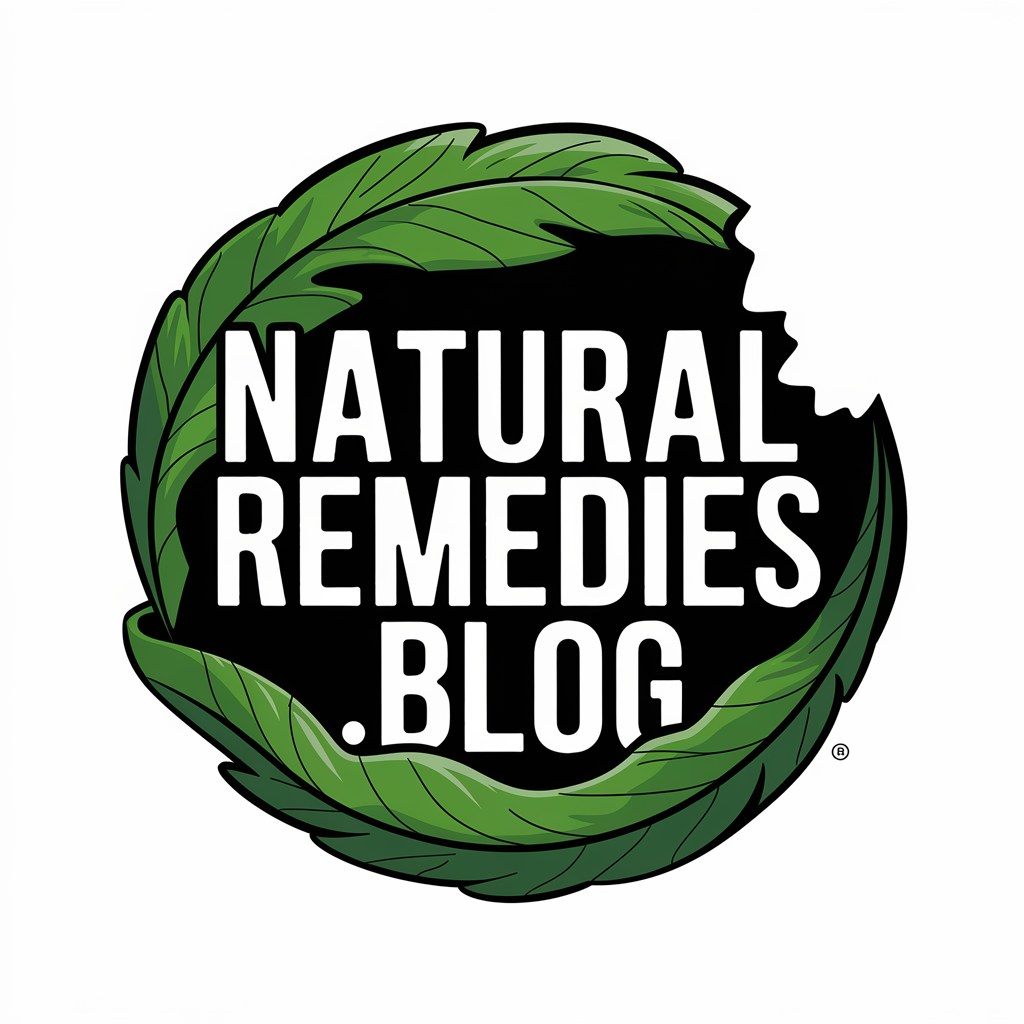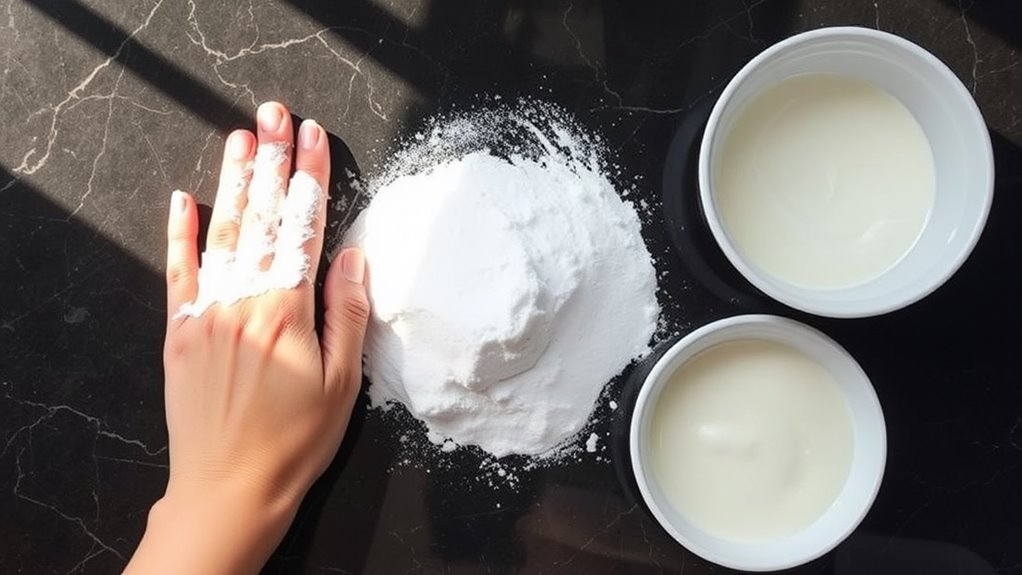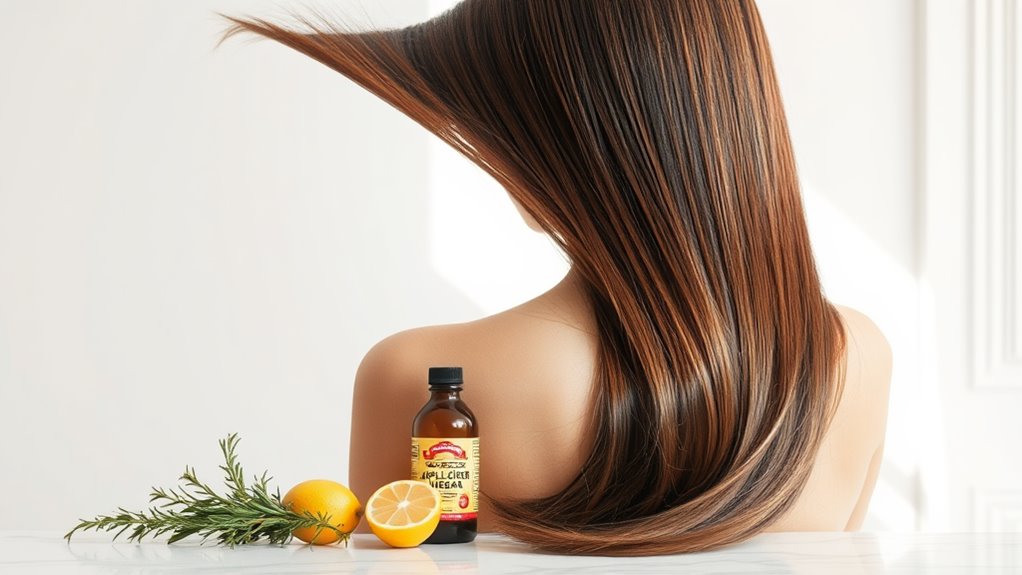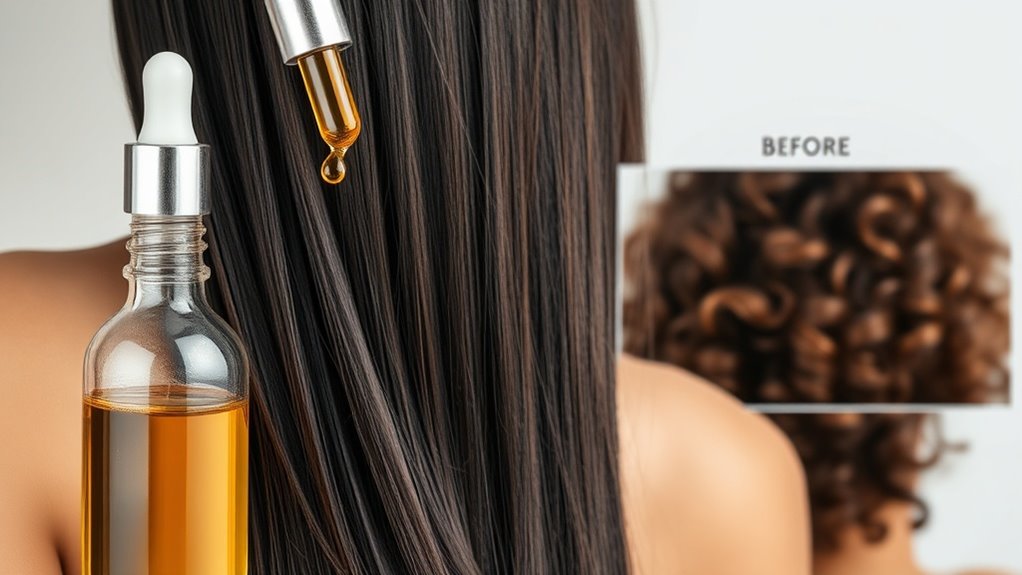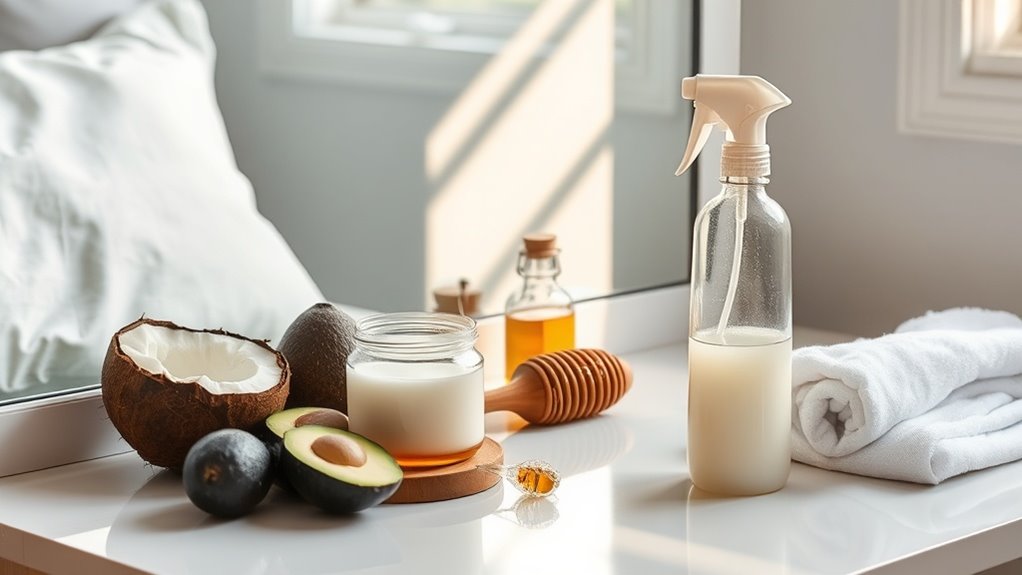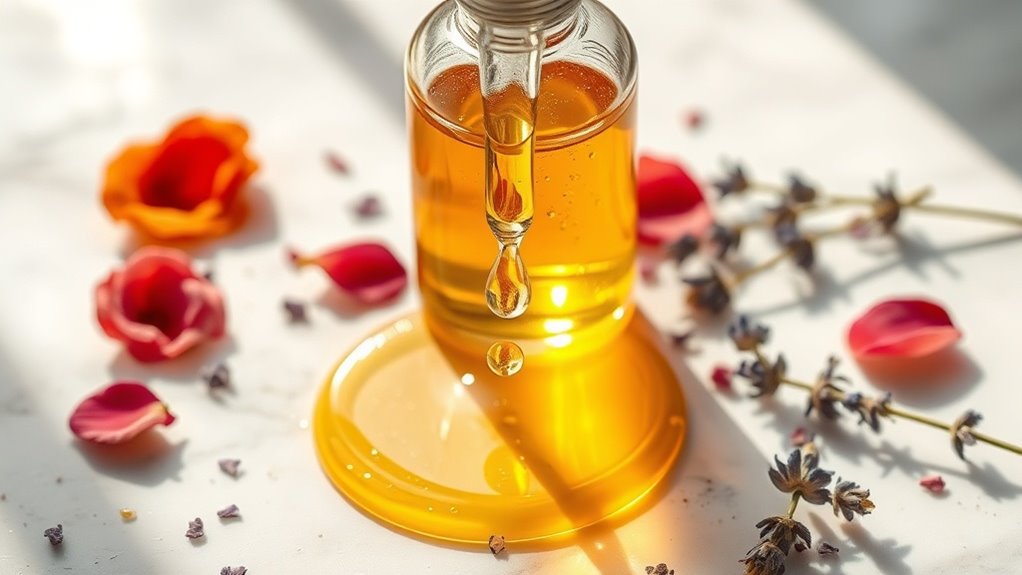Baking Soda for Oily Skin- Does It Actually Work.
While baking soda can temporarily reduce oil and exfoliate your skin due to its alkaline pH of 8.4 and fine crystalline texture, it’s not recommended for regular use. Its high alkalinity disrupts your skin’s natural pH balance of 4.5-5.5, potentially triggering increased oil production and barrier damage. If you choose to try it, limit use to once weekly with proper dilution. Understanding the science behind safer alternatives will help you make a more informed skincare decision.
Understanding Baking Soda and Its Properties
What makes baking soda such a versatile compound for skincare?
The answer lies in its unique chemical composition and properties.
As a mild alkaline substance with the formula NaHCO₃, baking soda’s crystalline structure allows it to act as a gentle exfoliant. One of the primary baking soda uses stems from its pH level of 8.4, making it effective at neutralizing acidic compounds on your skin. Additionally, its properties as an amphoteric compound allow it to maintain balanced pH levels when applied to skin, which is essential for addressing skin concerns effectively.
Its non-toxic, biodegradable nature and ability to dissolve readily in water (69g/L) make it safe for topical application. The compound’s stability at room temperature guarantees consistent performance in skincare formulations.
The Science Behind Oily Skin Management
Your skin’s pH balance directly influences sebum production, with imbalances potentially triggering your sebaceous glands to produce excess oil.
The mechanism of oil production involves complex hormonal and environmental factors that affect your skin’s sebaceous glands, which can produce up to 1.45 mg of sebum per square centimeter of skin surface. Disruption of the skin’s acid mantle can lead to increased oiliness and sensitivity.
When your skin’s pH rises above its natural level of 4.5-5.5, you’ll typically experience increased sebum production as your skin attempts to restore balance through compensatory mechanisms.
Sebum production tends to be particularly high during spring and summer months, leading to increased oiliness during warmer seasons.
Ph Balance and Sebum
The complex relationship between skin pH and sebum production plays a crucial role in managing oily skin conditions.
Your skin naturally maintains a slightly acidic pH between 4.5 and 5.5, which is essential for proper enzymatic function and barrier protection.
Sebum, working with sweat, helps maintain this delicate pH balance while providing waterproofing properties.
When pH levels become elevated, you’ll experience increased enzyme activity that can break down your skin barrier, leading to more oil production and potential infections.
This disruption particularly affects those with oily skin, as altered pH can stimulate excess sebum secretion and compromise your skin’s defensive capabilities.
The acid mantle created by this pH balance acts as a critical defense mechanism against harmful bacteria and environmental damage.
Understanding Oil Production Mechanisms
Scientists have identified complex mechanisms underlying sebum production that directly impact oily skin management.
Your sebaceous glands produce sebum through specific biochemical pathways, with muscarinic acetylcholine receptors playing a vital role in this process. The mixture contains lipids and fatty acids that form part of your skin’s protective barrier.
Three key factors influence your skin’s oil production:
1. Sebaceous gland size and activity, which determines sebum volume
2. Hormonal signals, particularly CRH and stress-related hormones
3. Triglyceride breakdown by bacterial enzymes, affecting sebum composition
Understanding these mechanisms helps explain why certain treatments work better than others in managing oily skin, particularly those targeting sebum production pathways.
Benefits of Baking Soda for Skin Care
You’ll find that baking soda’s alkaline properties help neutralize excess oils on your skin’s surface while maintaining natural moisture levels. Its fine granular texture provides gentle yet effective exfoliation, removing dead skin cells and unclogging pores without harsh abrasion. Additionally, its antibacterial properties help fight acne, further enhancing its benefits for oily skin. When used as part of your skincare routine, baking soda’s dual action of oil control and exfoliation can lead to a smoother, more balanced complexion. Being an affordable skincare option, baking soda offers a cost-effective alternative to expensive commercial products.
Natural Oil Control Properties
People seeking relief from oily skin often discover that baking soda’s natural oil control properties make it an effective skincare solution.
Its absorbent qualities help regulate excessive oil production while maintaining your skin’s delicate pH balance.
When you use baking soda on your skin, you’ll experience:
- Active absorption of excess sebum that contributes to clogged pores and shine
- Natural antimicrobial action that fights acne-causing bacteria
- Deep pore cleansing that removes accumulated dirt and oil buildup
This versatile ingredient‘s ability to neutralize acids while providing antimicrobial benefits makes it particularly effective for managing oily skin concerns. Research demonstrates that a 10 g/L solution of sodium bicarbonate effectively inhibits the growth of various fungal strains commonly found on human skin.
Gentle Exfoliation Benefits
Beyond its oil-controlling properties, baking soda offers remarkable exfoliation benefits through its naturally fine, crystalline structure.
When you apply it in gentle circular motions, the granules effectively remove dead skin cells and unclog pores without harsh abrasion.
Regular weekly use can improve your skin’s texture and brightness by accelerating cell turnover and reducing surface buildup.
You’ll notice smoother, more radiant skin and less visible pores over time.
However, limit applications to 1-2 times weekly for 3-5 minutes to prevent barrier disruption.
Always follow with moisturizer to maintain hydration and protect your skin’s natural balance.
Regular use can disrupt natural bacteria on your skin’s surface, potentially leading to increased breakouts and infections.
Potential Risks and Side Effects to Consider
While baking soda has gained popularity as a natural remedy for oily skin, its potential risks warrant careful consideration.
Its high alkalinity (pH 9) can severely disrupt your skin’s natural pH balance (4.5-5.5), leading to significant complications.
Consider these critical risks:
-
Immediate skin barrier disruption, causing dryness, irritation, and increased sensitivity.
-
Long-term damage to your skin’s protective barrier, making it more vulnerable to infections and breakouts.
-
Excessive stripping of natural oils, which paradoxically triggers increased oil production and potential acne flare-ups.
Additionally, baking soda’s antibacterial properties may not be effective for everyone and could lead to adverse reactions in sensitive skin types.
For safer alternatives, opt for pH-balanced cleansers specifically formulated for oily skin.
How to Safely Use Baking Soda on Your Skin
Despite the potential risks, baking soda can be used safely on oily skin when following specific protocols and precautions. Create a paste by mixing 1 teaspoon of baking soda with 2 teaspoons of water. Apply this diluted mixture only to oily areas like your T-zone, using gentle circular motions. Limit applications to 1-2 times weekly and leave on for just 5 minutes. Always follow with a moisturizer to restore your skin’s barrier. Additionally, baking soda acts as a mechanical exfoliant and can help remove dead skin cells. Patch test first and discontinue if irritation occurs. Remember to protect your skin with sunscreen, as baking soda can increase UV sensitivity.
Alternative Treatments for Oily Skin
For those seeking alternatives to baking soda treatments, numerous evidence-based options can effectively manage oily skin.
Clinical research supports several proven approaches that target excess sebum production and improve skin texture.
- Topical treatments like retinoids and hydroxy acids help regulate oil production while improving cell turnover.
- Professional treatments such as chemical peels and botulinum toxin injections provide significant sebum reduction.
- Natural remedies including 3% green tea emulsion and niacinamide show measurable benefits in clinical studies. Additionally, coconut oil’s antibacterial properties can also help combat skin irritation associated with oily skin.
Consider discussing these evidence-based options with a dermatologist to determine the most suitable treatment for your skin type.
Expert Recommendations and Best Practices
Leading dermatologists and skincare experts have established clear guidelines for using baking soda safely on oily skin.
You’ll need to limit applications to 1-2 times weekly to prevent pH disruption and skin irritation.
Always dilute baking soda with water before use, and pair it with soothing ingredients like oat flour or aloe vera to minimize potential irritation.
After each treatment, you must apply a moisturizer to maintain skin hydration.
Consider combining baking soda with coconut oil or honey for enhanced benefits.
While effective for oil control and gentle exfoliation, overuse can lead to sensitivity and delayed skin recovery. Regular use of baking soda can promote smoother, more even-toned skin by removing dead cells and unclogging pores.
References
- https://www.jintegrativederm.org/article/122501-baking-soda-and-the-skin-a-review-of-baking-soda-in-dermatology
- https://www.healthline.com/health/beauty-skin-care/baking-soda-for-skin
- https://www.medicalnewstoday.com/articles/321137
- https://www.jintegrativederm.org/api/v1/articles/122501-baking-soda-and-the-skin-a-review-of-baking-soda-in-dermatology.pdf
- https://www.healthline.com/health/baking-soda-acne
- https://pubchem.ncbi.nlm.nih.gov/compound/Sodium-Bicarbonate
- https://en.wikipedia.org/wiki/Sodium_bicarbonate
- https://byjus.com/chemistry/preparation-properties-and-uses-baking-soda/
- https://axial.acs.org/cross-disciplinary-concepts/the-science-of-baking-soda
- https://www.sciencing.com/physical-chemical-properties-sodium-bicarbonate-6571412/
